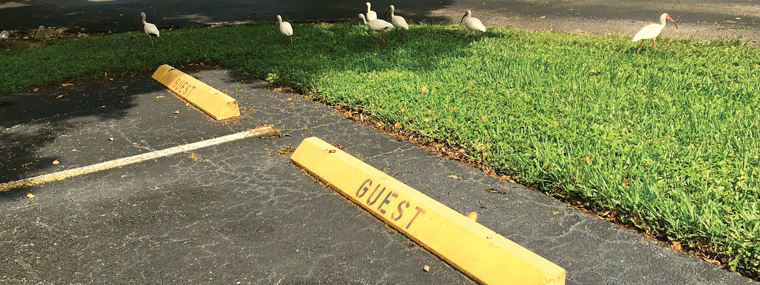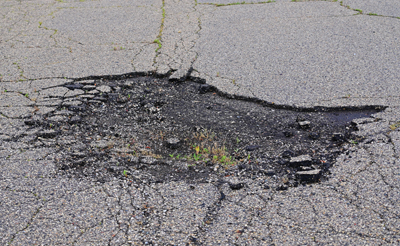
What Cracked the Blacktop?
By Rodger E. Rowles / Published February 2023

Maintenance is the key to saving money! My March 2022 article in the Florida Community Association Journal entitled “High Oil Prices Drive Up Cost of Paving Projects” addressed the immediate need for your HOA to seriously consider a pavement maintenance program.
Implementing a cost-effective maintenance program must be considered now while your pavements are in good condition. Pavements in poor condition should also be upgraded now. If your HOA has not had a reassessment of your pavement reserves in the past year, one should be done as soon as possible. The cost of paving asphalt has risen dramatically.
Your asphalt pavements and roads may look ok; however, it’s what you don’t see that is the problem. Pavements deteriorate in stages as measured by the Pavement Condition Index (PCI), from good to poor as measured in years. In Florida the number of years is less than in other parts of the country due to the hot, sunny days.
As a result of tight budgets and rising material costs, owners and property managers should be looking for alternatives to extend pavement life through proactive preventive maintenance methods. The tight U.S. oil markets and the slowing refining supply chain will result in the continuing increase of paving asphalt costs. You may be able to wait out the inflation spiral, but can your asphalt paving and reserves?
So, what did crack the asphalt? Was it base failure, oxidation, doing nothing, or the wrong maintenance product? What choice should you make, and is there another answer or choice that has a proven track record?
Base Failure: This is the wear and tear from heavy traffic. In this case milling and paving is the only option, which will require complete removal of the blacktop, removal of the base material in failed areas, and a replacement of the aggregate and regrading prior to new hot-mix asphalt installation.
Oxidation: The aging process of asphalt is the leading cause of asphalt deterioration. The sun’s UV rays cause the oxidative hardening of the asphalt binder (the glue that holds the pavement together), which increases the cracking and deterioration of the pavement. Most of the aging in an asphalt pavement occurs in the top ½ inch. Testing has shown that most of the asphalt aging (increase in viscosity) occurs in this portion of an asphalt pavement within the first four to five years. Oxidation causes hardening. The question is, will a surface seal or seal coat protect the asphalt pavement from (1) gasoline and oil; (2) sun and UV light; (3) water and chemicals, and (4) salt and air (oxygen)?
Doing Nothing: This has proven time and again to be the costliest option. Asphalt has a design life of 15 to 25 years. If the right maintenance treatment is not taken at the right time, this will eventually lead to base failure. The pavement will need a costly overlay or mill and overlayment.
Seal Coating: For many years this was the only alternative to “doing nothing.” Seal coating is nothing more than a paint job with minimum short-term benefits and is technically obsolete. The major negative side effect of seal coat is cracking. The truth is, in most cases the sealer is cracking the pavement. When the cracks appear, the first reaction is to reseal. However, with each additional seal coat the depth and width of the cracks increase. Cracks allow air and water to enter the pavement. This exacerbates the oxidative hardening, weakening the entire pavement structure. When the aesthetics of the pavement look that bad, the reaction is to repave. However, it is the surface cracking from the use of the wrong maintenance product that gives this appearance. Repaving may be premature because the pavement has not reached the end of its structural life.
Asphalt Rejuvenation Technology: This has proven to be the best choice. The bottom line is that CPR [concrete pavement rejuvenation] works. Asphalt deterioration is a chemical as well as a physical process. CPR Rejuvenator penetrates the blacktop 3/8 to ½ inch, stops and reverses oxidative hardening, and becomes part of the pavement. CPR is in the pavement, not on it, so there is no surface sealer to crack. CPR lasts four to five years instead of two to three years using emulsion products. The one-coat application of CPR is installed by a high-production machine, which avoids the additional down time and inconvenience of moving your customers or residents as often. CPR Rejuvenator offers more benefits at a competitive price and provides value by improving the appearance and image of your business or property while saving you money. CPR Rejuvenator is today’s choice!
Visit our website at Pavement Rejuvenation Technologies Group (PRT-Group.com) or call 484-557-0353. Our technical staff is available to evaluate your asphalt pavement needs and offer cost-effective solutions.
Rodger E. Rowles
President and CEO, Pavement Rejuvenation Technologies Group Inc.
Rodger E. Rowles is president and CEO of Pavement Rejuvenation Technologies Group Inc. (PRT-Group.com). The PRT-Group, incorporated in 1997, provides an informational website to educate contractors in the pavement maintenance services business. The focus is the development of asphalt pavement rejuvenator as a cost-effective maintenance product. The PRT-Group has certified contractors throughout the United States using CPR rejuvenator technology. Rodger is the National Sales representative for CPR Rejuvenator and the sales and service contact for Desco Manufacturing’s D-200 rejuvenator applicator. Rodger was the president and CEO of R.E. Rowles Asphalt Inc., a Philadelphia, PA- based commercial asphalt paving and maintenance company, from 1979 to 2020. Contact Rodger at rodgerintransit@prt-group.com, PRT-Group.com, or 484-557-0353.





